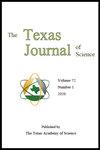初步分析表明,淡水无脊椎动物环境DNA在地表水中的浓度高于底栖沉积物
Q4 Agricultural and Biological Sciences
引用次数: 0
摘要
摘要淡水无脊椎动物的收集、鉴定和普查有助于提高对湖泊和溪流生态功能的认识。然而,这项工作既费时又费力,因为无脊椎动物的鉴定往往需要大量的分类训练和专业知识。环境DNA (eDNA)是生物体释放到周围环境中的遗传物质,它的收集和分析代表了一种潜在的革命性方法,可以在淡水环境中快速准确地监测无脊椎动物。先前的研究表明,淡水湖沉积物中的鱼类eDNA往往比上面的水柱更丰富,因此我们进行了一项实验,以检验这种模式是否适用于淡水无脊椎动物。我们在德克萨斯州拉伯克市的一个城市湖泊周围的十个地点收集了底栖生物沉积物和水柱的成对样本。基于针对COI基因的通用无脊椎引物的定量PCR (qPCR)扩增的循环阈值,配对Wilcoxon符号秩检验和Spearman秩序相关表明,无脊椎动物eDNA的数量在沉积物和水柱之间存在相关性,但与沉积物相比,水中的eDNA浓度始终更高,这与之前对鱼类eDNA的研究直接形成对比。结合eDNA检测和高通量测序(即元条形码)的未来工作将增加对eDNA信号与当地无脊椎动物池的关系的理解,并增加淡水无脊椎动物eDNA采样的效用。本文章由计算机程序翻译,如有差异,请以英文原文为准。
PRELIMINARY ANALYSIS SUGGESTS FRESHWATER INVERTEBRATE ENVIRONMENTAL DNA IS MORE CONCENTRATED IN SURFACE WATER THAN IN BENTHIC SEDIMENTS
Abstract The collection, identification, and census of freshwater invertebrates helps to increase understanding of the ecological function of lakes and streams. However, this work can be time-consuming and laborious because invertebrate identification often requires considerable taxonomic training and expertise. The collection and analysis of environmental DNA (eDNA), the genetic material that organisms shed into their surrounding environment, represents a potentially revolutionary approach for rapid and accurate invertebrate surveillance in freshwater environments. Previous studies have demonstrated that fish eDNA tends to be more abundant in freshwater lake sediments than the water column above, so we conducted an experiment to examine whether this pattern holds true for freshwater invertebrates. We collected paired samples from benthic sediments and the water column at ten sites around an urban playa lake in Lubbock, Texas. Based on cycle threshold values from quantitative PCR (qPCR) amplification with universal invertebrate primers targeting the COI gene, a paired Wilcoxon signed-rank test and Spearman rank-order correlation suggested that invertebrate eDNA quantities were correlated between the sediment and water column but consistently more concentrated in the water compared to the sediment below, directly contrasting with previous studies of fish eDNA. Future work combining eDNA detection and high-throughput sequencing (i.e., metabarcoding) will increase understanding of how eDNA signals relate to local invertebrate pools and increase the utility of eDNA sampling for freshwater invertebrates.
求助全文
通过发布文献求助,成功后即可免费获取论文全文。
去求助
来源期刊

The Texas Journal of Science
Agricultural and Biological Sciences-Ecology, Evolution, Behavior and Systematics
CiteScore
0.50
自引率
0.00%
发文量
2
期刊介绍:
Scholarly manuscripts reporting original research results in any field of science or technology, including science education, will be considered for publication in The Texas Journal of Science. Prior to acceptance, each manuscript will be reviewed by both knowledgeable peers and the editorial staff. Authors are encouraged to suggest the names and addresses of two potential reviewers to the Manuscript Editor at the time of submission of their manuscript.
 求助内容:
求助内容: 应助结果提醒方式:
应助结果提醒方式:


